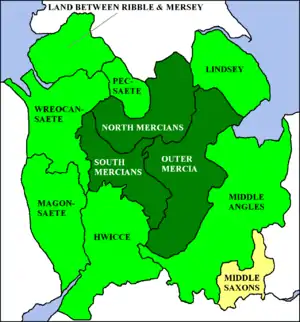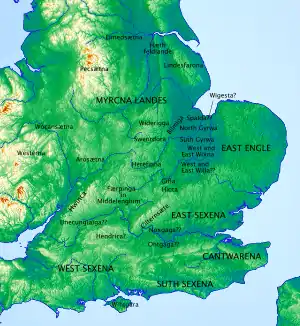Пексет
Пексет (англосакс.: Pēcsǣtan[1]) — англосаксонська держава, утворена після 590 року саксами, що оселились на землях племені бриґантів та завойованого ними королівства Пік. Перебувало у васальній залежності від Мерсії. На початку VIII століття територія Пексету увійшла до складу Мерсії.

Пексет на мапі Мерсії
| |||||||||||||||||
Розташовувалось у південній частині Пеннінських гір, нині територія графства Дербішир, на захід від Рокенсету, на схід від Елмету, на північ від Мерсії та на південь від Нортумбрії. Територія Пексету дорівнювала 1200 гайдам[2], відповідно до «Tribal Hidage».
Назва Пексет буквально означає «мешканці вершини».
Джерела
- Bigsby, R. «Historical and Topographical Description of Repton». London, 1854.
- Collis, J. «Wigber Low Derbyshire: A Bronze Age and Anglian Burial site in the White Peak». Department of Archaeology and Prehistory, University of Sheffield, 983.
- Davies, W. and Vierk, H. «The contexts of Tribal Hidage: social aggregates and settlement patterns», in Frühmittelalterliche Studien, viii (1974)
- Dumville, D. «The Tribal Hidage: an introduction to its texts and their history», in The Origins of the Anglo-Saxon Kingdoms ed. S.Bassett, 1989. ISBN 0-7185-1317-7
- Fowler, M. J. «The Anglian Settlement of the Derbyshire and Staffordshire Peak District». DAJ 1954, 74, 134—151.
- Hart, C. R. «The North Derbyshire Archaeological Survey». Leeds: A. Wigley & Sons, 1981.
- Hodges, R. and Wildgoose, M. «Roman or native in the White Peak», in Branigan, K. (ed) Rome and the Brigantes, 1980, 48–53. Sheffield, Sheffield University Press.
- Hodges, R. «Notes on the Medieval Archaeology of the White Peak». In R. Hodges and K. Smith (eds) Recent Developments in the Archaeology of the Peak District :111–122 (Sheffield Archaeological Monographs 2) Sheffield, 1991.
- Hughes, R. G «Archaeological Sites in the Trent Valley, 1961, South Derbyshire» DAJ 81, 149–50.
- Jones, H. The Region of Derbyshire and North Staffordshire from AD350 to AD700: an analysis of Romano-British and Anglian barrow use in the White Peak. Ph.D. thesis, University of Nottingham, 1997.
- Roffe, D. (1986b) «The Origins of Derbyshire» DAJ 106, 102—112.
- Routh, T. A «Corpus of the Pre-Conquest Carved Stones of Derbyshire» DAJ 1937, 58, 1–46.
- Sidebottom, P.C. Schools of Anglo-Saxon Stone Sculpture in the North Midlands. Unpublished PhD Thesis, University of Sheffield. 1994
- Sidebottom P.C (1999) «Stone Crosses in the Peak and the Sons of Eadwulf». DAJ 119, 206–19.
- Frank Stenton (1905) «Introduction to the Derbyshire Domesday», in W. Page (ed) The Victoria History of the County of Derbyshire. London.
- Unwin, T. (1988) «Towards a model of Anglo-Scandinavian rural settlement in England», in Hooke, D. (ed) Anglo-Saxon Settlements, 77–98.
- Barbara Yorke(1990) Kings and Kingdoms of Early Anglo-Saxon England, London: Seaby.
- Peter Featherstone, «The Tribal Hidage and the Ealdormen of Mercia», dans Michelle P. Brown et Carole A. Farr, Mercia: An Anglo-Saxon Kingdom in Europe, Continuum, 2001 ISBN 0-8264-7765-8
- Audrey Ozanne, «The Peak-Dwellers», Medieval Archaeology, vol. 6, 1962, p. 15-52.
- Barbara Yorke, Kings and Kingdoms of Early Anglo-Saxon England, Seaby, 1990 ISBN 1-85264-027-8
Примітки
-
 Hugh Chisholm, ред. (1911) «Derbyshire» // Encyclopædia Britannica (11th ed.) V. 8 Cambridge University Press p. 72 (англ.)
Hugh Chisholm, ред. (1911) «Derbyshire» // Encyclopædia Britannica (11th ed.) V. 8 Cambridge University Press p. 72 (англ.) - «Tribal Hidage»
This article is issued from Wikipedia. The text is licensed under Creative Commons - Attribution - Sharealike. Additional terms may apply for the media files.
